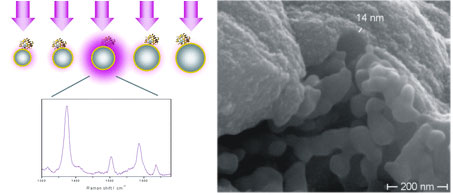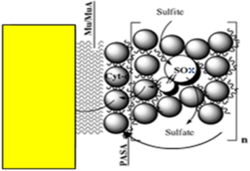B5 Bioelectronic building blocks
Photosynthesis, respiration, redox signalling and metabolism include multi-step electron transfer processes. Basic principles of these biological redox systems are transferred to electrodes in bioelectronic devices based on bioelectrocatalysis at the electrode interface, where architecture, material and surface design are crucial for an effective heterogeneous reaction. Functionalisation of conducting nanostructured material allows the binding of redox enzymes in order to exploit their highly specific catalytic properties for constructing bioelectronic sensors and biofuel cells.
Within this research field biocatalytic reactions at nano- and mesoscaled structures are investigated. The main goals are
- to elucidate fundamental aspects of the electronic properties in conductive nanostructure-enzyme hybrid material and
- to develop bioelectronic devices.
Results/Achievements
Initially within this project small redox proteins were explored followed recently by more complex heme and molybdenum enzymes, which can be used for bioelectrocatalysis, redox signalling and signal amplification in sensors for metabolites, biofuel cells, and nano-enzyme reactors for aromatic drugs.
Novel techniques and materials were developed and successfully tested and theoretically described with immobilized small biomolecules and proteins [ e.g., 1-8] and applied to understand and improve the biocatalytic behaviour of various immobilized enzymes of interest in the cluster, for example hydrogenases, sulfite oxidase and peroxygenase [9-12] with Research Fields B1, B2 and B3 and to develop bioelectronic devices.
Theoretical description of electron transfer and introduction of optics to biological systems at surfaces
Surface sensitive spectroscopies (SEIRA, SERS)
Polarised Raman measurements, TERS
New matrices for immobilization
Bioelectrocatalytic devices and analytical applications
Some important results are:
Fundamental aspects of electronic properties in enzyme hybrids were investigated using spectroscopic and electrochemical techniques. This also involved the development of novel spectroscopic techniques, such as time-resolved and near-field surface enhanced techniques, and the theoretical description [1, 2, 4, 5, 11]. For example a a physical and statistical approach has been developed describing the distance dependent electron transfer rate of immobilized proteins [4]. A model explaining the reaction of sulfite oxidase on modified gold electrodes has been derived using a combined spectroscopic and electrochemical approach [11].
The solutions of electromagnetic field equations on spatial nanometer scales can be considered as a specific extension of nano- and near-field optics to biochemical systems [3, 4, 5].
Novel SERRS active particles and surfaces including theory, for example a functionalized Ag-Au hybrid device for electrochemical SER(R)spectroscopy in a wide potential and spectral range [3, 6].
- Prototypes of biosensors for sulfite, aldehydes, and drugs species, which have been developed by introduction of layered enzyme-protein architectures [10, 12] and nanoparticles to enhance the efficieny of the biocatalytic processes [9].
A bioelectrocatalytic device containing cytochrome c immobilized in porous high surface area transparent and conductive film with which the measurement of reactive oxygen species [7, 8 ] (see also Research Field A 3).
A biomimetic approach for monitoring drugs using microperoxidase in a chitosan-gold nanoparticle matrix.
Most important publications
Polarised Raman measurements on the core complex of crystallised photosystem II; Katharina Brose, Athina Zouni, Matthias Broser, Frank Müh, and Janina Maultzsch, Phys. Status solid 2009, 246, 2813-2816.
Resonance Raman spectra of β-carotene in solution and in photosystems revisited: an experimental and theoretical study; Norman Tschirner, Matthias Schenderlein, Katharina Brose, Eberhard Schlodder, Maria Andrea Mroginski, Christian Thomsen and Peter Hildebrandt, Physical Chemistry Chemical Physics 2009, 11, 11471-11478.
Novel Au-Ag Hybrid Device for Electrochemical SE(R)R Spectroscopy in a Wide Potential and Spectral Range; Jiu-Ju Feng, Ulrich Gernert, Murat Sezer, Uwe Kuhlmann, Daniel H. Murgida, Christin David, Marten Richter, Andreas Knorr, Peter Hildebrandt, and Inez M. Weidinger, Nano Letters 2009, 9, 1, 298-303.
Distance-dependent electron transfer rate of immobilized redox proteins: A statistical physics approach; Sören Georg, Julia Kabuss, Inez M. Weidinger, Daniel H. Murgida, Peter Hildebrandt, Andreas Knorr, and Marten Richter, Phys Review 2010, 81, 046101.
Theory of time-resolved Raman scattering and fluorescence emission from semiconductor quantum dots; Julia Kabuss, Stefan Werner, Axel Hoffmann, Peter Hildebrandt, Andreas Knorr, and Marten Richter, Phys. Review 2010, 81, 075314.
Y. Aksu, S. Frasca, U. Wollenberger, M. Driess, A. Thomas; A molecular precursor approach to tunable porous tin-rich indium tin oxide with durable high electrical conductivity for bioelectronic devices; Chem. Mater. 2011, 23, 1798-1804.
Mesoporous Indium Tin Oxide as a Novel Platform for Bioelectronics; S. Frasca T. von Graberg, J. J. Feng, A. Thomas, B. M. Smarsly, I. M. Weidinger, F. W. Scheller, P. Hildebrandt, U. Wollenberger ChemCatChem 2010, 2, 839 – 845.
Peroxygenase based sensor for aromatic compounds; Lei Peng, Ulla Wollenberger, Matthias Kinne, Martin Hofrichter, René Ullrich , Katrin Scheibner, Anna Fischer, Frieder W. Scheller, Biosensors and Bioelectronics 2010, 26, 1432-1436.
Spricigo, R., Dronov, R., Lisdat, F., Leimkühler, S. Scheller, F.W., and Wollenberger, U. (2009) Electrocatalytic sulfite biosensor with human sulfite oxidase coimmobilized with cytochrome c in a polyelectrolyte containing multilayer. Anal. Bioanal. Chem. 393: 225-33.
Sezer M, Spricigo R, Utesch T, Millo D, Leimkühler S, Mroginski MA, Wollenberger U, Hildebrandt P, Weidinger IM. (2010) Redox properties and catalytic activity of surface-bound human sulfite oxidase studied by a combined surface enhanced resonance Raman spectroscopic and electrochemical approach. Phys Chem Chem Phys. 12:7894-903.
Spricigo, R., Richter, C., Leimkühler, S., Gorton, L. Scheller, F.W., Wollenberger, U. (2010) Sulfite biosensor based on osmium redox polymer wired sulfite oxidase. Colloids and Surfaces.
Project team and expertise
| Dr. Anna Fischer (TU Berlin) | Design and synthesis of porous electrodes for enzyme immobilization |
| Prof. Dr. Peter Hildebrandt (TU Berlin) | Redox enzymes, spectroelectrochemistry |
| Prof. Dr. Andreas Knorr (TU Berlin) | Nano- and near field optics, electron transfer |
| Dr. Marga Lensen (TU Berlin) | Scanning probe microscopy, surface nanopatterning with gold |
| Prof. Dr. Janina Maultzsch (TU Berlin) | Optical near field spectroscopy |
| Prof. Dr. Frieder W. Scheller (Uni Potsdam) | Bioanalysis, biosensors, bioelectronics |
| Prof. Dr. Ulla Wollenberger (Uni Potsdam) | Electrochemistry, biosensors |
Former team members | |
| Prof. Dr. Stephanie Reich (FU Berlin) | Photoluminescence, CNS |
| Prof. Dr. Christian Thomsen (TU Berlin) | Carbon nanotubes, vibrational spectroscopy |




